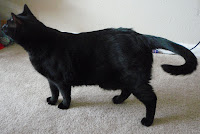Monday, January 25, 2010
One step closer!
Thursday, January 14, 2010
Vacation Dieting?
Thursday, January 7, 2010
Cheaters!
I guess everybody cheats on their diet every now and again.
Tuesday, January 5, 2010
Sunday, January 3, 2010
The First Step: What goes in


What weight loss blog would be complete without before and after shots? Check out the fat ripples! Stay tuned for videos…when Midnight walks/run his tummy fat sways up almost halfway up his back.
The first step to any weight loss program is nutritional management. We looked up the daily energy requirements (DER) for the average cat, and based on body weight Midnight needs 428 kcal to maintain his current weight. We feed our cats Iam’s Proactive food currently, and are already feeding him under the recommended amount. We were giving him roughly 360 kcal daily, which shows how the average recommendation doesn’t work for everyone.
For a cat diet, nutritionist recommended to reduce the diet by 20% for safe gradual weight loss. So to meet his weight loss goals, Midnight is receiving ½ cup per day.
We also had to change the way we feed the cats. Previously we fed all of the cats a measured amount once a day, and they grazed on it over time. This was a problem in a group of cats; Midnight was taking advantage and eating more than his share! So now when we are feeding everyone we take away food after the cats have finished. Midnight can’t graze throughout the day on everyone else’s chow anymore.
Also we are feeding the cats 2-3 times a day instead of once a day. Digesting the food takes energy, so by multiplying the number of feeds, we are increasing the energy needed to process the food. We are boosting the amount of calories he is burning without any change in behavior. Multiple meals also boost the metabolism.
If you are interested in looking up energy requirements for your pets, here are some good resources: A very good (and very dense academic resource!) book is Hand & Novotny’s Pocket Companion to Small Animal Clinical Nutrition. Easier to use are http://www.talktothevet.com/ARTICLES/CATS/feedadultcat.HTM to find out the number of calories to feed a cat and http://www.scheyderweb.com/cats/catfood.html to calculate how many calories are in the cat food. While they are not perfect, they are good resources to get you started. Any weight loss plans should also include guidance from a veterinarian to avoid any health complications.Friday, January 1, 2010
New Year's Resolutions
 We are the owners of six wonderful cats. To some this may seem excessive, but we have reached a balance that is good for both the people and the cats. Both of us work at vet clinics and recently brought in our menagerie for vaccines. Along with their shots, we weighed all the cats. We have a group of healthy felines with little stomach pudges, normal for housecats, with the exception of Midnight.
We are the owners of six wonderful cats. To some this may seem excessive, but we have reached a balance that is good for both the people and the cats. Both of us work at vet clinics and recently brought in our menagerie for vaccines. Along with their shots, we weighed all the cats. We have a group of healthy felines with little stomach pudges, normal for housecats, with the exception of Midnight. Midnight is a 2 year old black, domestic short hair cat. He is a polydactyl, coming in with 20 toes (a normal cat should have 14). On December 21st he weighed in at 21 pounds and 7 ounces. While Midnight is a stocky cat, big boned and long, this is about 7 pounds more than he should be. 7 pounds on this cat is comparable to being 90-100 pounds overweight on a human.
Of course, there are benefits to having a fat cat. Extra cat = more heating on your lap on cold days. Marc and I live in the Midwest making this is a definite benefit. But being so large, Midnight doesn't play like the other cats. He lies on his back, and bats at toys while the other cats jump and run around him. He sleeps more than the others do. Being overweight is not in Midnight’s current best interest, and can pose health problems later down the road.
What better time to get Midnight on track than at New Year’s? It isn’t going to be easy; in a multi-pet household, trying to diet one is very difficult. But for Midnight, we can do it!